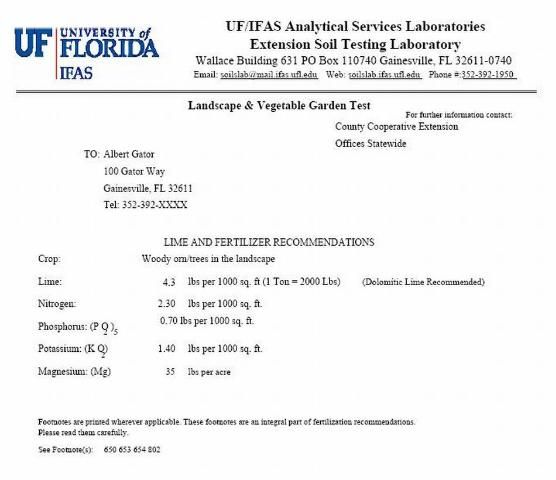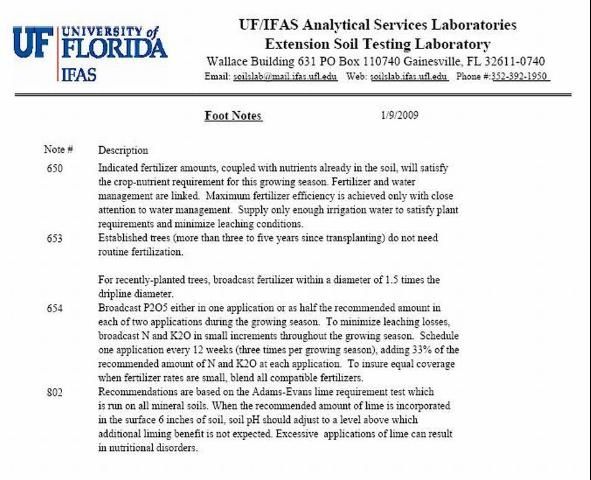Introduction
Plants require 14 mineral nutrients for proper growth and reproduction. For the most part, soil can supply sufficient amounts of these nutrients. However, in some cases, soils may not have enough of one or more essential nutrients to sustain plant growth. Soil testing is the most effective way to determine the nutrient status and pH of the soil in a home landscape or vegetable garden. Soil test results are useful to determine whether fertilizer or lime applications are needed. This publication provides information about taking a soil sample and how to understand the soil test report.
Taking a Soil Sample
In order to obtain reliable results from a soil test, the soil sample must be taken correctly. The soil sample should accurately represent the area that will be planted and managed. The items needed to take a soil sample include a plastic bucket, a shovel (or soil probe), and a paper bag or newspaper. Follow these steps to properly collect a soil sample:
- Identify the area to be sampled. Turf areas, vegetable gardens and ornamental beds should all be sampled separately. Also, any problem areas (such as depressions, rocky areas, etc.) should be sampled separately to avoid contaminating samples from good areas.
- Using a shovel (or soil probe), remove soil from 10 to 15 locations within the sampling area. Soil should be removed from the top 6 inches. Walk in a zigzag pattern, stopping occasionally to remove soil for the sample.
- After taking each sub-sample, remove any plant material or mulch and deposit the soil into the plastic bucket. Mix the soil in the bucket to ensure it is well blended.
- Spread the soil out on a newspaper or paper grocery bag and allow it to dry thoroughly.
- Once dry, pack approximately 1 pint of soil (fill to the dotted line) into a soil sample bag (available free from your local UF/IFAS Extension office). Alternatively, you may pack soil into a zip-top plastic bag.
Submitting a Soil Sample for Testing
Soil samples should be analyzed at the UF/IFAS Extension Soil Testing Laboratory (ESTL; http://soilslab.ifas.ufl.edu) or other reputable laboratory. The ESTL uses soil test methods that were developed specifically for Florida soils. The lab determines soil pH, lime requirement ("Adams-Evans" buffer test), and an index of available soil nutrients (the "Mehlich-3" soil test). These test methods have been calibrated across Florida and other Southeastern states for many years to ensure that the results are valid under Florida conditions. Private laboratories may or may not use soil tests that are calibrated for our region; therefore, if you choose to have your sample analyzed by a private laboratory, it is important that you know which tests are offered. Additionally, UF/IFAS fertilizer recommendations are specific to the soil tests offered through the ESTL, which is important when interpreting the results. For this reason, UF/IFAS fertilizer recommendations may not be valid if other soil test methods were used, which may be the case with soil test results obtained from a private laboratory.
Soil samples being submitted to the ESTL should be accompanied by a completed Landscape & Vegetable Garden Soil Test Information Form (EDIS publication SL136 https://edis.ifas.ufl.edu/SS187) and the associated test fee should be paid by an enclosed check or money order. Cash may be used if soil samples are delivered to the ESTL in person. The ESTL offers two soil tests for the home landscape and vegetable garden. Test A ($3) includes soil pH and lime requirement analyses; Test B ($7) adds analysis of phosphorus (P), potassium (K), calcium (Ca), and magnesium (Mg). The ESTL does not test soils for nitrogen (N). A reliable N soil test does not exist because the chemical forms of N in the soil are constantly changing due to Florida's warm and humid climate. For more information about how N reacts in the soil, see EDIS publication SL254 Nitrogen in the Home Landscape (https://edis.ifas.ufl.edu/SS479). If using another soil testing lab, you should contact it first to obtain instructions on how to submit soil samples.
Soil Test Results
Once the soil analysis is complete, a soil test report will be mailed (usually within 7 days after the ESTL receives the sample). For a quicker response, provide an email address and report(s) will be sent immediately upon completion of analysis. A copy of the soil test report will also be sent to your local county Extension agent, who you should contact if you have questions or need assistance interpreting the results. Figures 1–3 show an example of a soil test report from the ESTL.



The report includes information about the pH and nutrient availability index (as applicable) for each soil sample. In addition, the soil test report includes lime and fertilizer recommendations for selected lawn and landscape plants (Table 1). Fertilizer rate recommendations for N were determined by scientific research on plant response to N, whereas recommendations for P, K, Ca, and Mg are determined based on the index of nutrient availability (e.g. "low," "medium," "high," etc.) measured in the soil sample. The lime recommendation is based on the results of the pH and lime requirement test and the optimum pH for the turf or landscape plant species. Be sure to read the soil test report carefully and thoroughly (including all footnotes). Also, avoid comparing reports from ESTL with those from private laboratories. Private labs may use different analytical procedures, which may or may not be calibrated to conditions in Florida. Remember, your local UF/IFAS Extension office can answer questions related to soil test results (http://solutionsforyourlife.ufl.edu/map/).